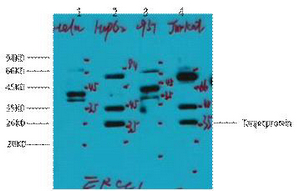
Catalog: YP1699
Size
Price
Status
Qty.
200μL
$600.00
In stock
0
100μL
$340.00
In stock
0
50μL
$190.00
In stock
0
Add to cart


Collected


Collect
Main Information
Target
S10A9
Host Species
Rabbit
Reactivity
Human, Mouse, Rat
Applications
WB
MW
13kD (Calculated)
Conjugate/Modification
Phospho
Detailed Information
Recommended Dilution Ratio
WB 1:500-2000
Formulation
Liquid in PBS containing 50% glycerol, 0.5% BSA and 0.02% sodium azide.
Specificity
This antibody detects endogenous levels of S100A9 (Phospho-Thr113) at Human, Mouse,Rat.The name of modified sites may be influenced by many factors, such as species (the modified site was not originally found in human samples) and the change of protein sequence (the previous protein sequence is incomplete, and the protein sequence may be prolonged with the development of protein sequencing technology). When naming, we will use the "numbers" in historical reference to keep the sites consistent with the reports. The antibody binds to the following modification sequence (lowercase letters are modification sites):EGtP
Purification
The antibody was affinity-purified from rabbit serum by affinity-chromatography using specific immunogen.
Storage
-15°C to -25°C/1 year(Do not lower than -25°C)
Concentration
1 mg/ml
MW(Calculated)
13kD
Modification
Phospho
Clonality
Polyclonal
Isotype
IgG
Related Products
Antigen&Target Information
Immunogen:
Synthesized peptide derived from human S100A9 (Phospho-Thr113)
show all
Specificity:
This antibody detects endogenous levels of S100A9 (Phospho-Thr113) at Human, Mouse,Rat.The name of modified sites may be influenced by many factors, such as species (the modified site was not originally found in human samples) and the change of protein sequence (the previous protein sequence is incomplete, and the protein sequence may be prolonged with the development of protein sequencing technology). When naming, we will use the "numbers" in historical reference to keep the sites consistent with the reports. The antibody binds to the following modification sequence (lowercase letters are modification sites):EGtP
show all
Gene Name:
S100A9 CAGB CFAG MRP14
show all
Protein Name:
S100A9 (Phospho-Thr113)
show all
Other Name:
Protein S100-A9 ;
Calgranulin-B ;
Calprotectin L1H subunit ;
Leukocyte L1 complex heavy chain ;
Migration inhibitory factor-related protein 14 ;
MRP-14 ;
p14 ;
S100 calcium-binding protein A9 ;
Calgranulin-B ;
Calprotectin L1H subunit ;
Leukocyte L1 complex heavy chain ;
Migration inhibitory factor-related protein 14 ;
MRP-14 ;
p14 ;
S100 calcium-binding protein A9 ;
show all
Database Link:
Background:
S100 calcium binding protein A9(S100A9) Homo sapiens The protein encoded by this gene is a member of the S100 family of proteins containing 2 EF-hand calcium-binding motifs. S100 proteins are localized in the cytoplasm and/or nucleus of a wide range of cells, and involved in the regulation of a number of cellular processes such as cell cycle progression and differentiation. S100 genes include at least 13 members which are located as a cluster on chromosome 1q21. This protein may function in the inhibition of casein kinase and altered expression of this protein is associated with the disease cystic fibrosis. This antimicrobial protein exhibits antifungal and antibacterial activity. [provided by RefSeq, Nov 2014],
show all
Function:
Function:Expressed by macrophages in acutely inflammated tissues and in chronic inflammations. Seem to be an inhibitor of protein kinases. Also expressed in epithelial cells constitutively or induced during dermatoses. May interact with components of the intermediate filaments in monocytes and epithelial cells.,miscellaneous:Has been shown to bind calcium.,similarity:Belongs to the S-100 family.,similarity:Contains 2 EF-hand domains.,subunit:Interacts with CEACAM3 in a calcium-dependent manner.,
show all
Cellular Localization:
Secreted. Cytoplasm . Cytoplasm, cytoskeleton . Cell membrane ; Peripheral membrane protein . Predominantly localized in the cytoplasm. Upon elevation of the intracellular calcium level, translocated from the cytoplasm to the cytoskeleton and the cell membrane (PubMed:18786929). Upon neutrophil activation or endothelial adhesion of monocytes, is secreted via a microtubule-mediated, alternative pathway (PubMed:15598812). .
show all
Tissue Expression:
Calprotectin (S100A8/9) is predominantly expressed in myeloid cells. Except for inflammatory conditions, the expression is restricted to a specific stage of myeloid differentiation since both proteins are expressed in circulating neutrophils and monocytes but are absent in normal tissue macrophages and lymphocytes. Under chronic inflammatory conditions, such as psoriasis and malignant disorders, also expressed in the epidermis. Found in high concentrations at local sites of inflammation or in the serum of patients with inflammatory diseases such as rheumatoid, cystic fibrosis, inflammatory bowel disease, Crohn's disease, giant cell arteritis, cystic fibrosis, Sjogren's syndrome, systemic lupus erythematosus, and progressive systemic sclerosis. Involved in the formation and deposition of amyloids in the aging prostate known as corpora amylacea inclusions. Strongly up-regulated in many tumors, including gastric, esophageal, colon, pancreatic, bladder, ovarian, thyroid, breast and skin cancers.
show all
Research Areas:
>>IL-17 signaling pathway
show all
Signaling Pathway
Reference Citation({{totalcount}})
Catalog: YP1699
Size
Price
Status
Qty.
200μL
$600.00
In stock
0
100μL
$340.00
In stock
0
50μL
$190.00
In stock
0
Add to cart


Collected


Collect
Recently Viewed Products
Clear allPRODUCTS
CUSTOMIZED
ABOUT US
Toggle night Mode
{{pinfoXq.title || ''}}
Catalog: {{pinfoXq.catalog || ''}}
Filter:
All
{{item.name}}
{{pinfo.title}}
-{{pinfo.catalog}}
Main Information
Target
{{pinfo.target}}
Reactivity
{{pinfo.react}}
Applications
{{pinfo.applicat}}
Conjugate/Modification
{{pinfo.coupling}}/{{pinfo.modific}}
MW (kDa)
{{pinfo.mwcalc}}
Host Species
{{pinfo.hostspec}}
Isotype
{{pinfo.isotype}}
Product {{index}}/{{pcount}}
Prev
Next
{{pvTitle}}
Scroll wheel zooms the picture
{{pvDescr}}



















